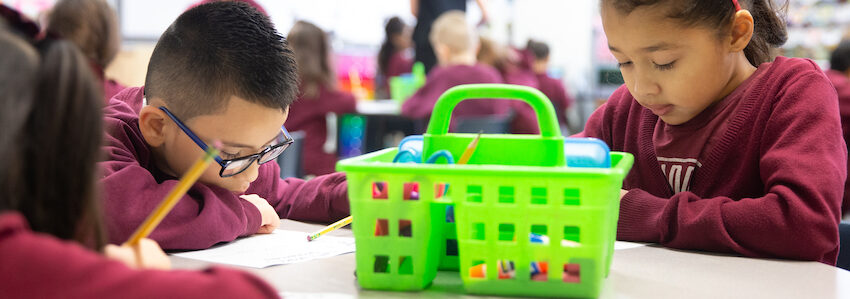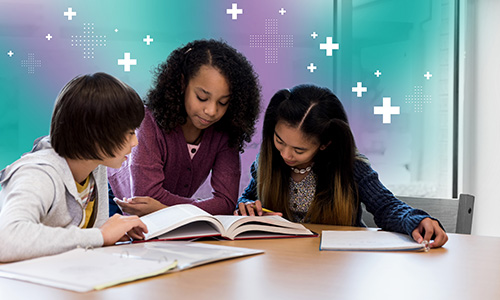
How can we support all learners in an academically diverse classroom? Will providing supports to some give them an unfair advantage? We can begin to address these common concerns by thinking about signs.
Supports are all around us
Frequently, in our day-to-day activities in the community, we encounter signs posted in various places: placards indicating self-serve checkouts in the grocery store, information about how to appropriately sort materials at the recycling center, posters explaining equipment use at the gym. A frequent patron might not need such reminders, or might only occasionally refer to them, but new visitors certainly do rely on such posted information for a successful experience. The signage presents no harm or inconvenience, and even occasional benefit, for many visitors, while being critical to others.
Thinking about signs in the community can remind us that what’s needed by some individuals poses no barrier—and can even sometimes be beneficial—for others.
One doesn’t have to look too hard to find other environmental features that support accessibility, inclusivity, and fairness for some individuals without posing a barrier to others: a sign language interpreter at a public event, an entry ramp on a building, a handrail on stairs. Again, some people rely on these for full participation in spaces and events, and there’s no harm done or extra advantage for those not needing them.
Supports in schools
The school environment parallels the greater community in many ways, including the heterogeneity of the people found within. The impetus to support accessibility, inclusivity, and fairness is surely at least as strong for children in school as for the general population in the community. This aim often manifests as features that are tailored to specific students and unlikely to be used by many others, such as Braille materials, instruction in a student’s home language (when not English), or a weighted pencil for students with fine-motor issues. Accommodations like these are typically mandatory per a student’s IEP or other support plan and are therefore likely to be implemented consistently.
Other student needs, formally identified or not, might not call for such explicit or obvious supports. Teachers must utilize a wide range of accommodations and modifications to ensure accessibility, inclusivity, and fairness for all students, including those with linguistic differences, those in need of scaffolding, and those who could benefit from extension.
How to support students with writing
Previous Teach. Learn. Grow. posts have focused on integrating supports for success in math and reading. Fair, accessible, and inclusive writing instruction calls for many of the same approaches while also presenting some unique opportunities to expand one’s toolbox of strategies.
Supports for success in writing instruction must be dynamic and responsive to changing student needs and learning goals. To that end, teachers may utilize general or targeted strategies, employed flexibly as appropriate, including differentiation of the content, process, and/or environment. These may include:
- Establishing student ownership and an authentic purpose for writing. Students are more engaged with a writing task that they find personally meaningful and that they believe will be impactful for others, and engagement is a key component of inclusivity. The more constrained and contrived the task, the less students feel ownership and meaningful purpose. As much as possible, allow students to write for self-directed, authentic purposes.
- Teaching mnemonic devices. Mnemonic devices are memory tools with broad utility across the curriculum. Mnemonics, such as acronyms and acrostics, can serve as critical scaffolds for helping students access the complex writing tasks of planning, organizing, developing, and even revising and editing. A quick online search will reveal many tried-and-true acronyms, such as POW, TREE, TIDE, and COPS, but you and your students might create some of your own.
- Modeling. We frequently think of modeling as useful in math and reading instruction, but it can also be a powerful addition to the writing instruction toolbox. Help make writing tasks accessible by modeling processes, techniques, and products. Seeing their teacher expand a paragraph with facts from a source, for example, can give students the needed framework for implementing a parallel task in their own writing.
- Providing specific, targeted feedback. Vague feedback (like “needs work” or “getting better”) is just as unhelpful in writing as in other scenarios. At the other extreme, too much feedback at once on a draft can be overwhelming and leave students feeling frustrated and unable to take action. Aim for feedback that is actionable and focused. Feedback is an especially useful tool for differentiation; it can be tailored to each student’s needs, including reteaching, linguistic support, and extension challenges.
- Using flexible peer learning groups. Flexible grouping is a powerful tool for bolstering accessibility, inclusivity, and fairness by facilitating targeted instruction and support. In the writing classroom, students may participate in flexible groups for various purposes: planning and brainstorming, peer review, and targeted grammar/mechanics skill groups, among others. While there may be occasion for using random or student-selected groups, aim for deliberate grouping informed by students’ situational needs for the greatest impact. See “NWEA guidance for student grouping” for more information on best practices for using flexible peer groups.
Many instructional strategies that support accessibility, inclusivity, and fairness can be delivered via self-regulated strategy development, or SRSD. SRSD is especially powerful for students with learning disabilities but can be useful for all students. Components of accessible, inclusive, and fair instruction also follow Universal Design for Learning (UDL) guidelines, a widely applicable framework for reducing barriers to learning. SRSD and UDL are not mutually exclusive but can be merged for maximal impact in planning and delivering writing instruction.
Closing thoughts
Supports for success are all around us. Buildings often feature door levers instead of knobs; you may even have some in your home. These can be essential for individuals with limited hand mobility but also helpful to others, as when hands are full or dirty. Skilled teachers employ instructional techniques that function similarly—providing varying levels of support, from minimal to intensive—to maximize accessibility, inclusivity, fairness, and, ultimately, student learning.







